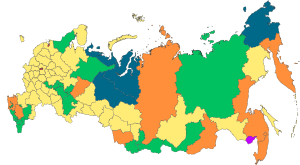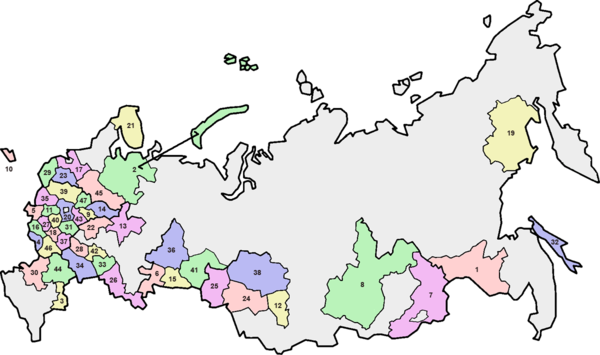أبلاستات روسيا
| Oblasts | |
|---|---|
 Oblasts of Russia (yellow) | |
| التصنيف | Federated state |
| الموقع | Russian Federation |
| العدد | 46 (internationally recognised) |
| عدد السكان | 156,996 (Magadan Oblast) – 7,095,120 (أبلاست موسكو) |
| المساحة | 15 100 km2 (Kaliningrad Oblast) - 767 900 km2 (Irkutsk Oblast) |
| الحكومة | Oblast Government, Oblast Duma |
| التقسيمات | Raion, City of oblast significance, Selsoviet, Okrug, Urban-type settlement |
In Russia, the oblasts are 46 administrative territories; they are one type of federal subject, the highest-level administrative division of Russian territory.[1]
استعراض
Oblasts are constituent political entities in a federal union with representation in the Federation Council, and serve as a first-level administrative division. Each oblast features a state government holding authority over a defined geographic territory, with a state legislature, the Oblast Duma, that is democratically elected. The governor is the highest executive position of the state government in an oblast and is elected by the people. Oblasts are divided into raions (districts), cities of oblast significance (district-equivalent independent cities), and autonomous okrugs, which are legally federal subjects equal to an oblast but are administratively subservient to one. Two oblasts have autonomous okrugs: Arkhangelsk Oblast (Nenets Autonomous Okrug) and Tyumen Oblast (Khanty-Mansi Autonomous Okrug and Yamalo-Nenets Autonomous Okrug).
The term oblast can be translated into English as "province" or "region", and there are currently 46 oblasts, the most common type of the 85 federal subjects in Russia.[1] The majority of oblasts are named after their administrative center, the official term for a capital city in an oblast, which is generally the largest city. Exceptions to this include Leningrad Oblast and Moscow Oblast, which have no official capital, and Sakhalin Oblast, which is named after a geographic location. Leningrad Oblast and Sverdlovsk Oblast retain the previous names of Saint Petersburg and Yekaterinburg, respectively. Oblasts are typically areas that are predominantly populated by ethnic Russians and native Russian language speakers, and are mostly located in European Russia. The largest oblast by geographic size is Tyumen Oblast at 1,435,200 km2 (excluding autonomous okrugs Irkutsk Oblast is the largest at 767,900 km2) and the smallest is Kaliningrad Oblast at 15,100 km2. The most populous oblast is Moscow Oblast at 7,095,120 and the least populous is Magadan Oblast at 156,996.
Krais, another type of federal subject, are legally identical to oblasts and the difference between a political entity with the name "oblast" and one named "krai" is purely traditional.
التاريخ
In the Russian Empire, oblasts were a third-level administrative division, organized in 1849 and few in number, dividing the larger guberniyas (governorates) within the first-level krais. Following the numerous administration reforms during the Soviet era, the number of oblasts gradually increased as they became the primary top-level administrative division of the Soviet Socialist Republics (SSRs), the constituent political entities of the Soviet Union. These oblasts held very little autonomy or power, but when the Soviet Union dissolved into sovereign states along the lines of the SSRs, they became the first-level administrative divisions. The oblasts of the Russian SFSR, which transitioned into the Russian Federation, became the first-level administrative divisions of the new country and received greater devolved power.
During the 2022 Russian invasion of Ukraine, Russia annexed the Donetsk, Kherson, Luhansk and Zaporizhzhia regions of Ukraine.[2] While Donetsk and Luhansk were incorporated as republics, having their respective separate constitutions adopted since 2014 back when they were two breakaway states of Ukraine, Kherson and Zaporizhzhia were annexed de jure, but not de facto, as regular oblasts. Including these, the Kremlin claims a total of 48 oblasts. The four regions remain internationally recognized as part of Ukraine and are only partially occupied by Russia and its control of the territory is not assured.[1]
القائمة
|
1. آمور |
16. لينينجراد |
33. سمارا |
المراجع
- ^ أ ب ت Heaney, Dominic, ed. (2023). The Territories of the Russian Federation 2023 (24th ed.). Abingdon: Routledge. ISBN 9781032469744.
- ^ "U.S. imposes new sanctions over Russia's illegal annexation". The Washington Post. 30 September 2022. Retrieved 30 September 2022.
